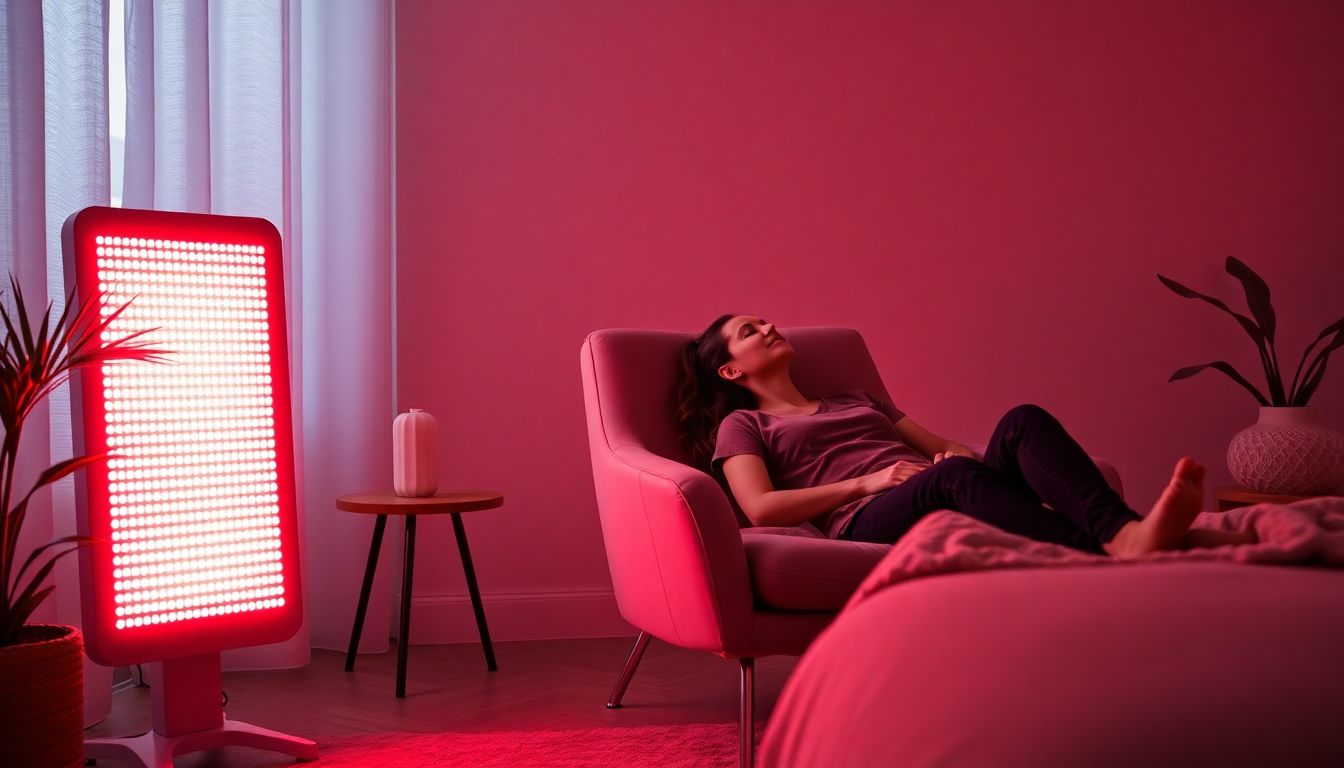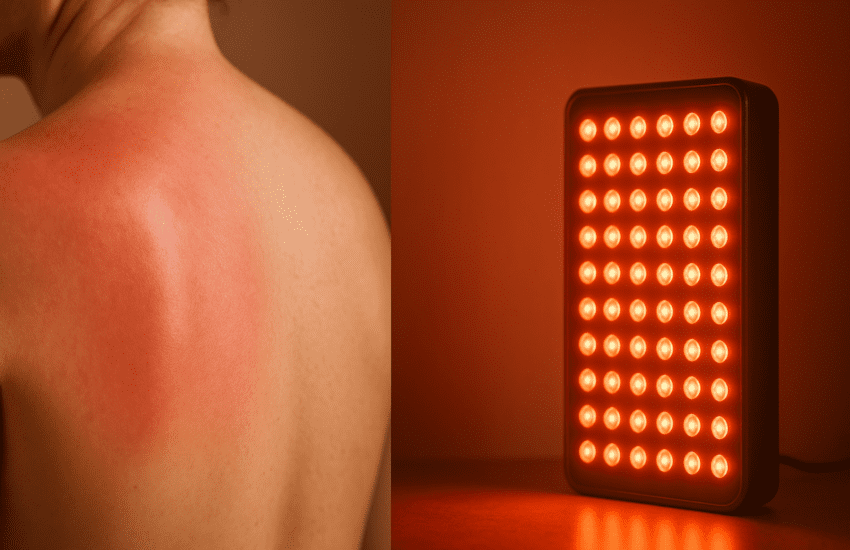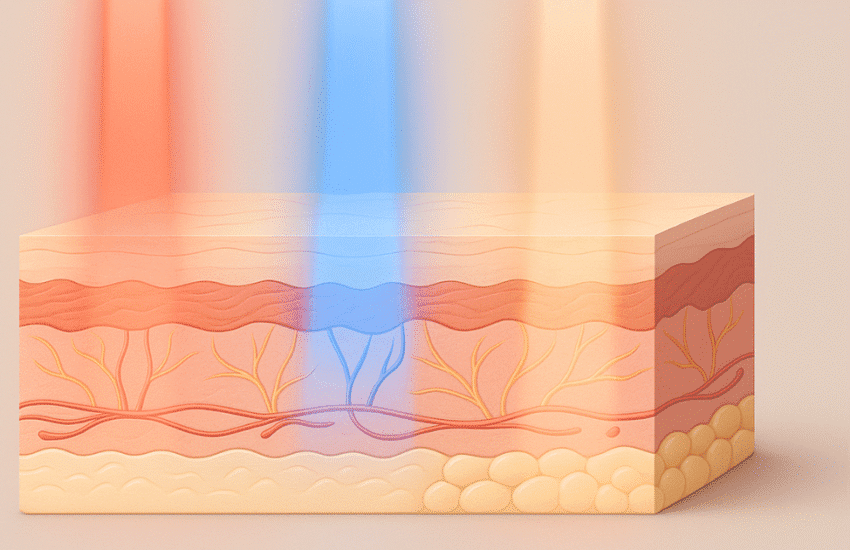Red Light Therapy at Home: Benefits, Devices & Best Practices
Red light therapy at home has evolved from exclusive clinical photobiomodulation treatments into user-friendly wellness devices you can use in your own living space.
Whether you choose an LED panel or a handheld unit, this DIY home wellness technology delivers targeted red (630–660 nm) and near-infrared (810–850 nm) wavelengths that penetrate skin and tissue to stimulate mitochondrial function, boost collagen production, and support natural cellular regeneration.
The result is a convenient, at-home approach to skin rejuvenation, pain relief, muscle recovery, and anti-aging—no appointment or prescription required.
Understanding How Red Light Therapy Works
Red light therapy uses specific wavelengths of light that penetrate your tissues without heat or harmful UV radiation. Think of it like sunshine minus the burn—these special light waves reach into your cells and get them buzzing with activity.
The magic happens when this light hits the mitochondria—tiny powerhouses inside your cells. This interaction boosts your ATP production (your body’s energy currency) and kicks off healing processes throughout your body. It’s like flipping on thousands of tiny switches that help your cells work better.
Red light (630-660nm) works mainly on your skin and surface tissues, while near-infrared light (810-850nm) dives deeper to reach muscles and joints. Scientists call this process photobiomodulation, but you can just think of it as giving your cells a gentle energy boost.
Key Benefits of Red Light Therapy at Home
Having your own red light therapy device means you can treat yourself whenever you need it—no appointments necessary. Like having a mini spa in your living room, home treatments let you maintain a regular schedule that builds benefits over time.
Daily or weekly sessions at home create cumulative effects that you simply can’t get from occasional clinic visits. Your skin gradually develops more collagen, leading to smoother texture and fewer wrinkles. Many users find their skin looks fresher after just a few weeks of consistent use.
The therapy also helps calm inflammation in sore joints and muscles. Athletes often use it after hard workouts to bounce back faster. Some people report sleeping better and feeling more balanced emotionally with regular evening sessions.
For those dealing with thinning hair, certain types of red light therapy may help stimulate growth. Just imagine getting all these potential benefits while relaxing at home with a good book or podcast!
Choosing the Right Home Red Light Therapy Device
The market is packed with options from small handheld units to impressive full-body panels. Not all devices are created equal, though, and quality makes a huge difference in your results.
When shopping, pay attention to power density (measured in mW/cm²) rather than just wattage. This tells you how much therapeutic light actually reaches your tissues. A stronger device means shorter treatment times and better results.
Think about what you want to treat. For targeting crow’s feet or a sore wrist, a small device might work fine. For back pain or full-body skin benefits, you’ll need a larger panel. It’s like choosing between a flashlight and a floodlight—both work, but for different purposes.
Check EMF levels and safety certifications before buying. A good device should have minimal EMF output and proper certifications. Also, investigate the warranty and company reputation—established brands typically offer better support and more reliable products.
Proper Treatment Protocols for Maximum Results
Getting results from red light therapy isn’t complicated, but it does require doing it right. Small tweaks to your routine can make a big difference in what you achieve.
Position yourself about 6-12 inches from your device—too close or too far and you won’t get the right amount of light. Start with short 5-10 minute sessions, then gradually work up to 15-20 minutes per area as your body adjusts.
Consistency is key! Use your device daily or at least 4-5 times weekly. Like watering a plant, regular attention leads to growth. Make sure your skin is clean and product-free during treatment so the light can penetrate properly.
Some devices recommend eye protection, so follow the guidelines that came with yours. Create a comfortable spot for your treatments—maybe next to your morning coffee spot or evening reading chair—to help make this new habit stick.
Common Mistakes to Avoid with Home Red Light Therapy
Even with simple technology, there are ways to accidentally reduce your results. Being aware of these pitfalls can save you time and frustration.
The biggest mistake is giving up too soon. Your body needs at least 4-8 weeks of consistent treatment to show noticeable changes. Cell regeneration is a gradual process—like growing a garden, not flipping on a light switch.
Never use red light therapy through clothing. Even thin fabrics block the therapeutic light from reaching your cells. Similarly, applying thick creams or oils before treatment creates a barrier that prevents the light from penetrating effectively.
Be wary of suspiciously cheap devices from unknown sellers. Some bargain units don’t deliver enough power to create real changes. It’s like buying a toy flashlight when you need a real one—the upfront savings lead to disappointment.
Combining Red Light Therapy with Other Wellness Practices
Red light therapy works even better when paired with other healthy habits. These combinations can multiply your results and make the therapy part of a larger wellness routine.
Try using your device right after exercise when your circulation is already boosted. This can help muscles recover faster and reduce next-day soreness. Many athletes swear by this combo for staying in peak condition.
Evening sessions can complement your body’s natural wind-down process. The gentle light and quiet moment of self-care signals to your body that it’s time to relax, potentially supporting better sleep patterns.
After treatment, your skin may better absorb quality skincare products. Wait about 10 minutes post-treatment, then apply your favorites. The increased circulation could help ingredients penetrate more effectively.
Consider snapping monthly progress photos or keeping notes about how you feel – these records help you notice gradual improvements that might otherwise be easy to miss, like slightly more even skin tone or better recovery from workouts.
Conclusion
Red light therapy at home brings professional-level care into your daily routine, offering a science-backed approach to supporting your body’s natural processes. With the right device and consistent use, you’re giving your cells the tools they need to function at their best.
Remember that patience matters—most users start seeing changes after 4-8 weeks, with continued improvements developing over several months. This isn’t an overnight fix but a long-term investment in your wellbeing.
By making red light therapy part of your regular routine and combining it with other healthy practices, you’re taking a proactive approach to looking and feeling your best.
Health Disclaimer: Consult a healthcare professional before starting any new wellness regimen, especially if you have existing health concerns. Individual results vary


